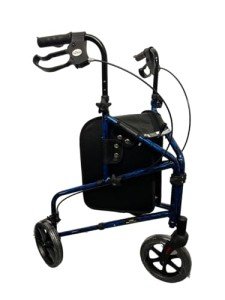This company has no active jobs
The Infrequently Known Benefits To Seat Walker
The Seat Walker: A Comprehensive Guide to Mobility Aids
When it pertains to keeping independence and mobility, people with limited mobility or impairments frequently rely on various assistive gadgets. One such gadget that progressively pertains to the forefront of mobility aids is the seat walker. This short article provides a thorough look at seat walkers-- their features, benefits, types, and the elements to consider when selecting one.

What is a Seat Walker?
A seat walker is a flexible mobility aid created primarily for individuals who might have difficulty NRS 4-Wheel Rollator: Walking Aid in Silver unaided. It typically includes a frame with wheels, manages for support, and a built-in bench or seat, allowing users to take breaks when needed. Unlike standard walkers or rollators, which just offer support for walking, the inclusion of a seat makes the seat walker substantially more functional for numerous users.
Key Features of Seat Walkers
- Wheels: Most seat walkers are equipped with front wheels that improve mobility and ease of use, enabling users to move smoothly over various surface areas.
- Seat or Bench: The most distinguishing feature is the integrated seat, which offers a resting place for users when tiredness sets in.
- Deals with: Adjustable manages cater to different user heights, offering adequate support and Helavo Lightweight Indoor Rollator For Effortless Movement making sure a comfy grip.
- Brakes: Safety brakes prevent the walker from rolling away when someone is seated, improving user security.
- Lightweight 3-Wheel Folding Walker with Bag Frame: Many designs are created to be lightweight, making them much easier to carry and maneuver.
Benefits of Using a Seat Walker
Seat walkers have many benefits that make them a perfect choice for many users.
- Boosted Mobility: They supply higher stability and support than standard walkers, reducing the risk of falls.
- Convenience: The ability to rest at any point makes them suitable for those who tire quickly or have actually restricted endurance.
- Independence: Seat walkers permit users to preserve a degree of self-reliance by allowing them to stroll and rest without support.
- Versatility: Suitable for both indoor and outdoor use, these walkers can adjust to different environments.
- Exercise: Regular use motivates exercise and social interaction, which can enhance general well-being.
Types of Seat Walkers
Different types of seat walkers deal with the differing needs of users. Here is a breakdown of the most typical types:
TypeFeaturesBest ForBasic Seat WalkerEasy style, frequently with a lightweight frame and minimal features.Users needing standard mobility assistance.Durable Seat WalkerStrengthened frame, higher weight capacity, typically with larger seats.Individuals needing more robust support.Rollator with SeatIntegrates seats with multi-height adjustable deals with and much better maneuverability.Users requiring frequent resting alternatives.Transport Seat WalkerDesigned for easy transport; often folds and has a small footprint.Active users who travel regularly.Picking the Right Seat Walker
Choosing a seat walker involves several factors to consider to guarantee it fulfills the user's particular needs. Here are necessary elements to bear in mind:

- Weight Capacity: Ensure that the seat walker can support the user's weight easily.
- Seat Height: Check the height of the seat to guarantee it is appropriate and comfy for the user.
- Width: Consider your home and make sure the Homecraft Walker Trolley: Wheels & Trays for Ease can fit through doors and narrow passages.
- Wheel Size: Larger wheels can manage rougher terrain, while smaller sized wheels are much better suited for indoor use.
- Weight of the Walker: A lightweight walker is helpful for simple maneuverability and transportation.
- Brakes and Safety Features: Look for trusted brakes and safety assurances, such as stability and anti-tip functions.
Setting a Budget
Seat walkers differ significantly in cost depending on their features and build quality. While it's necessary to discover a model that satisfies the user's requirements, it's similarly crucial to set a reasonable budget plan.
Average Price Ranges:
- Basic Models: ₤ 50 to ₤ 150
- Rollators with Added Features: ₤ 150 to ₤ 300
- Durable Models: ₤ 300 and up
Frequently Asked Questions About Seat Walkers
Q1: Who must use a seat walker?A1: Seat walkers are perfect for people with minimal mobility due to age, injury, or chronic conditions who need extra assistance while walking. Q2: Are seat walkers safe?A2: Yes, seat walkers are designed with safety in mind. They normally feature brakes, sturdy frames, and slip-resistant grips. Q3: How do I keep my seat walker?A3: Regularly examine the brakes and wheels for wear and tear.
Clean the frame with a wet cloth and make sure
screws and parts are tight. Q4: Can seat walkers be utilized outdoors?A4: Yes, lots of seat walkers are created for both indoor and outdoor use, though models with larger wheels carry out better on uneven surfaces. Q5: How do I know
which seat walker is right for me?A5: Consult with a doctor or occupational therapist who can examine your mobility needs and recommend appropriate options based upon your unique scenario. The convenience and adaptability of seat walkers make them an indispensable tool for those with mobility obstacles. By using support, stability, and a chance for rest, they empower users to stay active and independent. When picking a seat walker, individuals must consider their personal requirements, way of life, and safety to find the best match for them. With the best seat walker, many users can delight in a renewed sense of flexibility, boosting their quality of life and keeping their self-reliance. In summary, whether one is browsing through the home, running errands, or delighting in fresh air in a park, a seat walker can prove to be an important buddy, changing daily activities into workable tasks.

